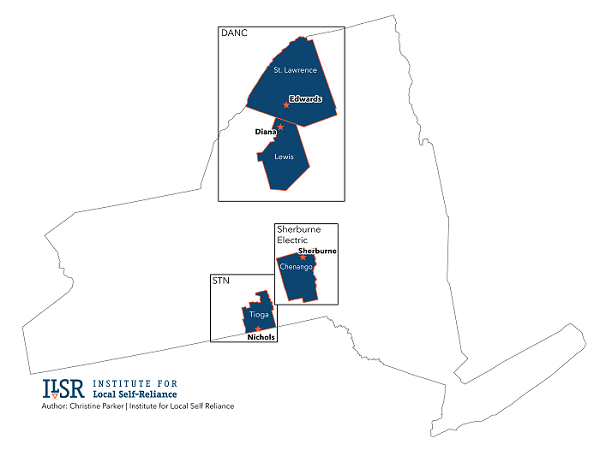Sean Gonsalves: New York’s First Bite of the Municipal Broadband Apple
Governor Kathy Hochul announced a $10-million grant award for the state’s first foray into municipal broadband.
Sean Gonsalves

Breaking new ground in New York, state leaders are launching the first municipal fiber-to-the-home projects in the Empire State with funds from its new ConnectALL initiative.
Four small rural communities in four different counties will be the beneficiaries of New York’s initial foray into municipal broadband, targeting “areas where existing state-owned fiber can create a fiber bridge between large data centers (first mile) and individual homes (last mile), primarily in rural areas that are not serviced by private broadband providers.”
At the end of May, Gov. Kathy Hochul’s office announced the $10 million grant award, which will fund fiber deployments to the Village of Sherburne in Chenango County, the Town of Nichols in Tioga County, the Town of Diana in Lewis County, and the Town of Pitcairn in St. Lawrence County.
A ‘banner day’ for municipal broadband
A collaborative project that includes the Empire State Development office, the Development Authority of the North Country and the Southern Tier Network, the initial deployment will be managed by the New York Power Authority and begin in Sherburne.

In Sherburne (est. pop. 1,300), NYPA will be joining forces with the village’s municipal utility, Sherburne Electric, a NYPA municipal electricity customer, to extend NYPA’s existing middle mile fiber network and bring last-mile FTTH connectivity to the village’s 1,800 homes and businesses. The work is expected to be completed by the end of the year with residential and business service to be offered by yet-to-be-named private Internet Service Providers (ISPs).
When the grant was announced, Sherburne Mayor William Acee lauded the effort as “a banner day for Sherburne Electric customers.”
“The prospect of having broadband Internet access available to all of Sherburne’s residents and businesses is the modern-day equivalent of the arrival of the railroad. New, affordable broadband Internet access will symbolically expand the boundaries of our community, and help forge deeper connections between Sherburne, and the world beyond,” Acee said.
When we spoke to Mayor Acee this week, he said, the plan is to build an open-access network and lease the infrastructure to private ISPs interested in providing the retail service.
Not only will the network ultimately offer Sherburne residents and businesses more choice in addition to the incumbent providers who already serve the area (Charter Spectrum, Frontier and FirstLight), Acee said, it will also enhance the municipal utility’s operations.
“As a municipally-owned electric system, one thing I’ve been pushing for is the ability to have a communication network that can handle load management and distributed energy resources and you need a robust communication system for that,” he said.
With the infusion of state grant funds, Acee said, it allows the previously planned network construction to be finished by the end of 2022 instead of the initial four-year timeline local planners originally thought.
Outside of Sherburne, the other three communities (Nichols in Tioga County, Diana in Lewis County, and Pitcairn in St. Lawrence County) will be next in line for what state leaders are calling a “ConnectALL Pilot Initiative.”
Incubating publicly-owned networks in new ecosystem
These new municipal broadband projects were made possible by a $220 billion state budget bill that was passed in April of this year and includes $1 billion for the state’s ConnectALL initiative, which Gov. Hochul’s office described as “the largest ever investment in New York’s 21st century infrastructure.”
The bill established an ecosystem for the cultivation of municipal broadband, a departure from New York state lawmaker’s previous approaches which relied on the existing telecom companies to solve the state’s connectivity challenges.
The bill created a municipal assistance program to provide grant funding to municipalities, state and local authorities to plan and build local, publicly-owned broadband infrastructure. It also repealed the fees associated with laying fiber cables along state highways and empowered the NYPA “to enter into lease agreements with other state instrumentalities and municipal entities for the use of excess capacity in the authority’s fiber optic communications infrastructure to provide affordable, high-speed broadband in unserved and underserved communities in the state.”
As Municipal Networks reported in April, that particular provision was important because NYPA has over 1,400 miles of transmission lines running across the state, much of which has fiber running in the same path. And the big telecom companies worked hard to block that provision from becoming law.
Looking even beyond the four communities that will first be targeted, NYPA’s middle mile infrastructure can now be used as backhaul by the dozens of communities in New York with municipal electric utilities currently served by NYPA, which would dramatically lower operation expenses for last mile fiber networks in those communities.
All of those towns and cities with municipal electric utilities have access to capital and an existing electric grid. They also own the poles, drops, and bucket trucks as well as have a trusted relationship with their ratepayers. With the addition of the NYPA provision, it will significantly lower barriers to community networks throughout the state.
This article originally appeared on the Institute for Local Self Reliance’s Municipal Broadband project on June 9, 2022, and is reprinted with permission.









Member discussion